Fact Checking Media and Helpful News Sources
> Lstorch
> COVID 19 - Remote Learning Resources
Double-click the icon (or click on the link under the title) to access the complete article or website.
Beat Digital Distraction with These Handy Chrome Extensions. Information Literacy Module Resources for Remote Teaching & Learning. Spotting Misinformation and #FakeNews: 10 Resources To Teach Students Media Literacy. Social media’s role in monitoring misinformation. Directions: Read the news summary, watch the video and answer the discussion questions.
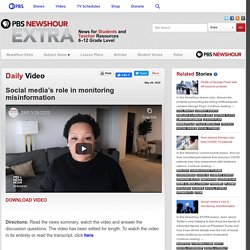
The video has been edited for length. To watch the video in its entirety or read the transcript, click here. Summary: President Donald Trump’s messages to his more than 80 million Twitter followers can carry a lot of weight—but don’t always represent the truth. A new initiative by Twitter to fact check the tweets of influential figures such as President Trump has stirred debate over the role of social media platforms as content moderators. For the first time this week, Twitter has applied a note to one of Trump’s tweets offering a fact check of his claims. Discussion questions:
Slowing the Infodemic: How to Spot COVID-19 Misinformation. In response to the significant amount of misinformation surrounding the COVID-19 pandemic, Thomson Reuters and the National Association for Media Literacy Education (NAMLE) are teaming up to provide high school and post-secondary educators with classroom resources that will inspire relevant and rich discussion about media literacy.
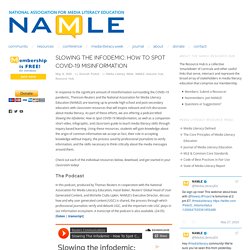
As part of these efforts, we are offering a podcast titled Slowing the Infodemic: How to Spot COVID-19 Misinformation, as well as a companion short video, infographic, and classroom guide to teach media literacy skills through inquiry based learning. Using these resources, students will gain knowledge about the origin of common information we accept as fact, their role in accepting knowledge without inquiry, the process used by professional journalists to verify information, and the skills necessary to think critically about the media messages around them.
Check out each of the individual resources below, download, and get started in your classroom today!
: The human cost of virus misinformation. Image copyright Getty Images A BBC team tracking coronavirus misinformation has found links to assaults, arsons and deaths.
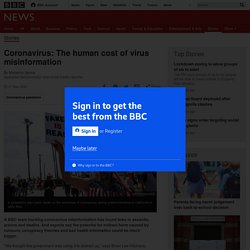
And experts say the potential for indirect harm caused by rumours, conspiracy theories and bad health information could be much bigger.
How to Avoid Misinformation About COVID-19. In mid-February, World Health Organization director-general Tedros Adhanom Ghebreyesus told an international security conference: “We’re not just fighting an epidemic.
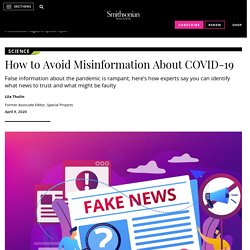
We’re fighting an infodemic.” As COVID-19 cases have surged across the globe, so has misinformation. According to research by the Bruno Kessler Foundation in Italy, every day in March 2020 an average of 46,000 new posts on Twitter linked to inaccurate or misleading information about the crisis. The rapidly changing situation means that people are naturally grasping for information about the pandemic. So what’s the best way to separate the trustworthy from the fake?
Get Smart About Memes. How to Fact-Check Like a Journalist with First Draft's Laura Garcia. The News Is Making People Anxious. You’ll Never Believe What They’re Reading Instead.
Though it can be hard to see past the daily deluge of devastating headlines, there is plenty of good news in the world right now — and a great deal of interest in reading it.
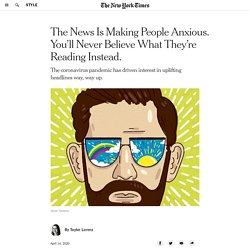
Instagram accounts dedicated to good news, such as @TanksGoodNews and @GoodNews_Movement, have seen follower counts skyrocket in recent weeks. At the end of March, the actor John Krasinski introduced a “news network for good news” on YouTube; within a week, Some Good News had surpassed 1.5 million subscribers and 25 million views.
Google searches for “good news” spiked a month ago and have only continued to rise. “We’ve seen an unprecedented level of growth in the past four weeks,” said Lucia Knell, the director of brand partnerships at Upworthy, who noted that the company saw a 65 percent growth in followers on Instagram and 47 percent increase in on-site page views in March, compared to the previous month. Upworthy was founded in 2012 with a commitment to positive storytelling. “There’s a line,” said Mr. Ms.
How to Fact-Check Like a Journalist with First Draft's Laura Garcia. Evaluating COVID 19 News. Coronavirus Racism Infected My High School.
Google Searches Can Help Us Find Emerging Covid-19 Outbreaks. Does the Google search data really mean that eye pain is a symptom of Covid-19?

NLP weighs in on the coronavirus and social media — News Literacy Project. NPR Choice page. Coronavirus pandemic: 8 ways to stop spread of COVID-19 misinformation. An epidemiologist answers the biggest questions she's getting about coronavirus.

Wochit The alarming messages ping our laptops and phones and parachute into our social media feeds, text messages and private chat groups. Be prepared for a national quarantine. Martial law is coming.The coronavirus was cooked up in a bioweapons lab by the CIA, or the pharmaceutical industry, or was funded by the Bill & Melinda Gates Foundation to boost vaccine sales.Sip water every 15 minutes, gargle with ethanol or eat raw garlic to ward off infection.
Virus outbreak means (mis)information overload: How to cope. CDC - Frequently Asked Questions. Until we know more about how this virus affects animals, CDC encourages pet owners to treat pets as you would other human family members to protect them from possible infection.
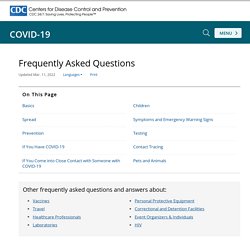
This means limiting contact between your pets and people outside your household as much as possible and avoiding places where large numbers of people gather. Some areas are allowing groomers and boarding facilities such as dog daycares to open. If you must take your pet to a groomer or boarding facility, follow any protocols put into place at the facility, such as wearing a mask and maintaining at least 6 feet of space between yourself and others if possible.
World Health Organization - Myth busters. Johns Hopkins Medicine - Coronavirus Disease 2019: Myth vs. Fact. There's a lot of information circulating about COVID-19, the disease caused by the new coronavirus, so it’s important to know what’s true and what’s not.
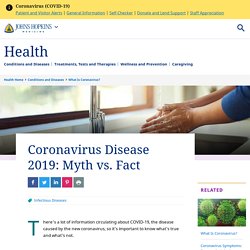
TRUE or FALSE? A vaccine to cure COVID-19 is available. The answer is false. There is no vaccine for the new coronavirus right now. Scientists have already begun working on one, but developing a vaccine that is safe and effective in human beings will take many months. TRUE or FALSE? The answer is false.
Misinformation, Data Literacy and the Novel Coronavirus. Teach students how to identify misinformation and stop its spread.
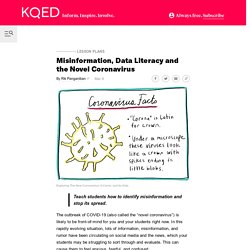
The outbreak of COVID-19 (also called the “novel coronavirus”) is likely to be front-of-mind for you and your students right now. In this rapidly evolving situation, lots of information, misinformation, and rumor have been circulating on social media and the news, which your students may be struggling to sort through and evaluate. This can cause them to feel anxious, fearful, and confused. That’s where you, the teacher, come in.
Common Sense Media Newsletter. Get smart about COVID-19 misinformation — News Literacy Project. COVID-19 journalism — News Literacy Project. A Russian-backed disinformation operation running more than 270 social media accounts and pages was uncovered in West Africa by investigative reporters at CNN working with two researchers from Clemson University. A “troll farm” in Ghana — based at a compound outside Accra, the capital — consisted of 16 people who worked exclusively on mobile phones to exacerbate racial divisions in the United States, CNN reported on March 13, while at least eight people were doing the same in Lagos, Nigeria.
They were hired by a purported nongovernmental organization, Eliminating Barriers for the Liberation of Africa (EBLA), and the first accounts were created last July. Focusing on racial issues in the United States, the workers, most of whom were in their 20s, shared links to stories about controversial topics, such as the use of excessive force by police, and posted inflammatory comments on Facebook, Instagram (which is owned by Facebook) and Twitter.
How Wikipedia Prevents the Spread of Coronavirus Misinformation. Coronavirus Disrupts Social Media’s First Line of Defense. Coronavirus: Protect Yourself and Stand Against Racism. Note to Teachers: News about the new coronavirus (COVID-19) has been evolving rapidly as the disease continues to spread. Stay informed about the latest information using the New York Times Coronavirus Briefing, which is updated daily, or another trusted news source.
The information in this Teaching Idea was last updated March 19, 2020. Since January, the world has been on high alert concerning the spread of the new strain of coronavirus, COVID-19. The virus, which in severe cases causes pneumonia, respiratory problems, and even death, emerged in Wuhan, China, in December and has since spread to all 50 states in the United States and to 145 countries across 6 continents. Explaining the News to Our Kids. News Literacy Resources for Classrooms. News and Media Literacy Resource Center. This Just In!
Finding Credible News. Fake animal news abounds on social media as coronavirus upends life. Scattered amid a relentless barrage of news about COVID-19 case surges, quarantine orders, and medical supply shortages on Twitter this week, some happy stories softened the blows: Swans had returned to deserted Venetian canals. Dolphins too. And a group of elephants had sauntered through a village in Yunnan, China, gotten drunk off corn wine, and passed out in a tea garden.
These reports of wildlife triumphs in countries hard-hit by the novel coronavirus got hundreds of thousands of retweets.
Investigating coronavirus media messages through magazine covers. Essential Digital Citizenship Lessons for the Coronavirus Pandemic. A Deep Dive into Deep Fakes Media Lite...ger Believing.
Wikipedia volunteers: Our best weapon against misinformation. Good News, Inspiring, Positive Stories - Good News Network. Informable app helps you build news literacy skills — News Literacy Project. If you are looking for an app that functions like a game and teaches you to be more news-literate, NLP has just the thing: Informable, our new mobile app. It is designed to improve users’ ability to distinguish between several types of news and other information.
Developed for both adults and students, Informable helps users practice four distinct news literacy skills using real-world examples in a game-like format. It is available now for download, at no charge, from the App Store (iOS) and Google Play (Android). Accuracy, speed count Informable (PDF) is intuitive and easy to navigate.
Coronavirus. Stop sharing myths about preventing the coronavirus. Here are 4 real ways to protect yourself. FactCheck.org Debunking False Stories Archives. The Coronavirus Collection: Memes and Misinformation - Snopes.com. The Sift Archive — News Literacy Project.










